新版六年级英语上册第一单元导学案
- 格式:doc
- 大小:239.00 KB
- 文档页数:18
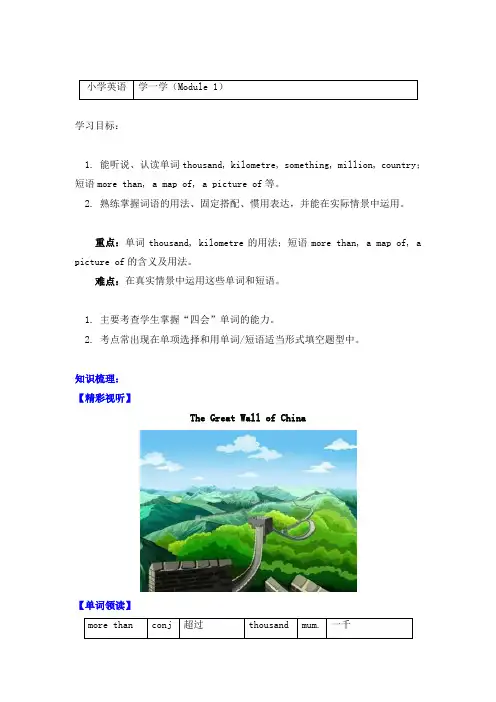
小学英语学一学(Module 1)学习目标:1. 能听说、认读单词thousand, kilometre, something, million, country;短语more than, a map of, a picture of等。
2. 熟练掌握词语的用法、固定搭配、惯用表达,并能在实际情景中运用。
重点:单词thousand, kilometre的用法;短语more than, a map of, a picture of的含义及用法。
难点:在真实情景中运用这些单词和短语。
1. 主要考查学生掌握“四会”单词的能力。
2. 考点常出现在单项选择和用单词/短语适当形式填空题型中。
知识梳理:【精彩视听】The Great Wall of China【单词领读】more than conj超过thousand mum. 一千1. more than 超过(1)more than +名词,表示“不仅仅是”。
如Jason is more than a teacher, he’s a writer.(2)more than +数词,表示“超过,以上,不止”之意。
如There are more than thirty children in the classroom.(3)more than +形容词,表示“很,非常”。
如I’m more than glad to help you.(4)more than +(that)从句,表示“超过”,可译成“难以,完全不能”。
如That is more than I can understand.It’s more than twenty thousand kilometres long.It has got more than eight million people.more...than(1)比……多He has more books than me.(2)与其……不如……He is more a writer than a teacher.Beijing has got more _______ twenty million people.A. thanB. thenC. over答案:A思路分析:北京有超过两千万人口。
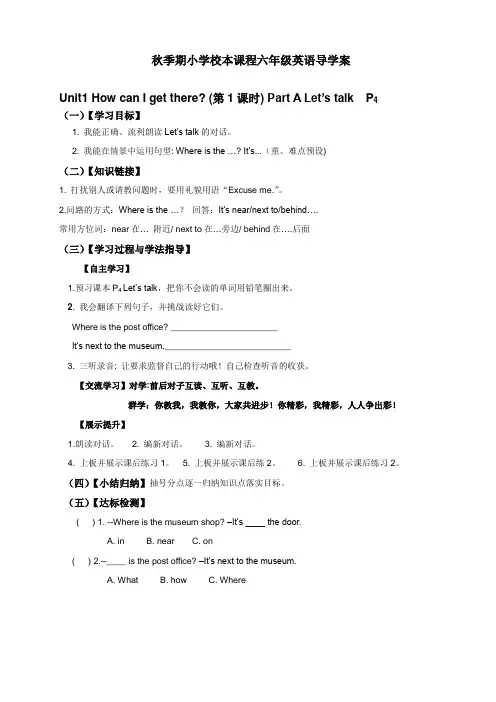
Unit1 How can I get there? (第1课时) Part A Let’s talk P4 (一)【学习目标】1. 我能正确、流利朗读Let’s talk的对话。
2. 我能在情景中运用句型: Where is the …? It’s...(重、难点预设)(二)【知识链接】1. 打扰别人或请教问题时,要用礼貌用语“Excuse me.”。
2.问路的方式:Where is the …?回答:It’s near/next to/behind….常用方位词:near在… 附近/ next to在…旁边/ behind在….后面(三)【学习过程与学法指导】【自主学习】1.预习课本P4 Let’s talk,把你不会读的单词用铅笔圈出来。
2. 我会翻译下列句子,并挑战读好它们。
Where is the post office? ______________________It’s next to the museum.__________________________3. 三听录音: 让要求监督自己的行动哦!自己检查听音的收获。
【交流学习】对学:前后对子互读、互听、互教。
群学:你教我,我教你,大家共进步!你精彩,我精彩,人人争出彩!【展示提升】1.朗读对话。
2. 编新对话。
3. 编新对话。
4. 上板并展示课后练习1。
5. 上板并展示课后练2。
6. 上板并展示课后练习2。
(四)【小结归纳】抽号分点逐一归纳知识点落实目标。
(五)【达标检测】( ) 1. --Where is the museum shop? –It’s ____ the door.A. inB. nearC. on( ) 2.--____ is the post office? –It’s next to the museum.A. WhatB. howC. WhereUnit1 How can I get there? (第2课时) Part A Let’s learn P5(一)【学习目标】1. 能听、说、认读单词:science museum, post office, bookstore , cinema, hospital (重点)2. 能在情景中运用句型: Where is the …? It’s...(难点预设)(二)【知识链接】1. 方位词:in front of(在…前面)behind(在…后面) near(附近) next to (与…相邻)2. near和next to的区别:near是指在某地方的周围,next to是指紧紧相邻。
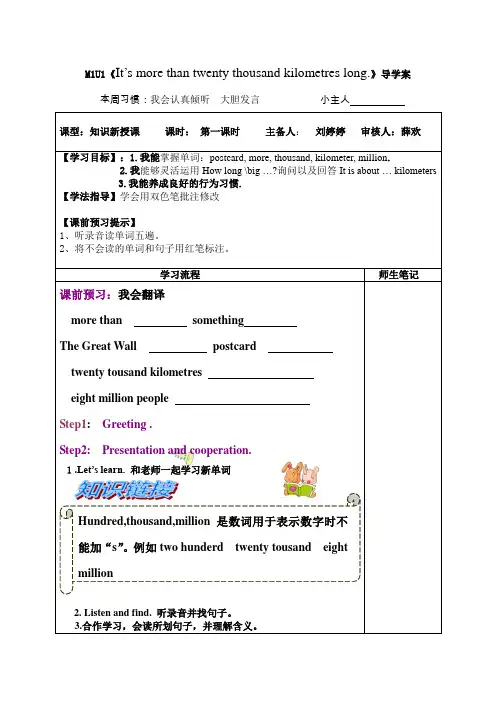
M1U1《It’s more than twenty thousand kilometres long.》导学案本周习惯:我会认真倾听大胆发言小主人课型:知识新授课课时:第一课时主备人:刘婷婷审核人:薛欢【学习目标】:1.我能掌握单词:postcard, more, thousand, kilometer, million.2.我能够灵活运用How long \big …?询问以及回答It is about … kilometers3.我能养成良好的行为习惯.【学法指导】学会用双色笔批注修改【课前预习提示】1、听录音读单词五遍。
2、将不会读的单词和句子用红笔标注。
学习流程师生笔记课前预习:我会翻译more than somethingThe Great Wall postcardtwenty tousand kilometreseight million peopleStep1: Greeting .Step2: Presentation and cooperation.1.Let’s learn. 和老师一起学习新单词Hundred,thousand,million是数词用于表示数字时不能加“s”。
例如two hunderd twenty tousand eightmillion2. Listen and find. 听录音并找句子。
3.合作学习,会读所划句子,并理解含义。
重点句子1.These postcards are great!2.It’s a picture of the Great Wall.3.Tell me more about..............4.Beijig has got about twentyn million people.Step3: Show孩子们,大显身手的时候到了!赶紧来分享一下自己的学习成果吧!根据下列任务条提示,选择你们喜欢的方式进行展示。
Come on!除了老师的提示,我们还有其他的创意 。
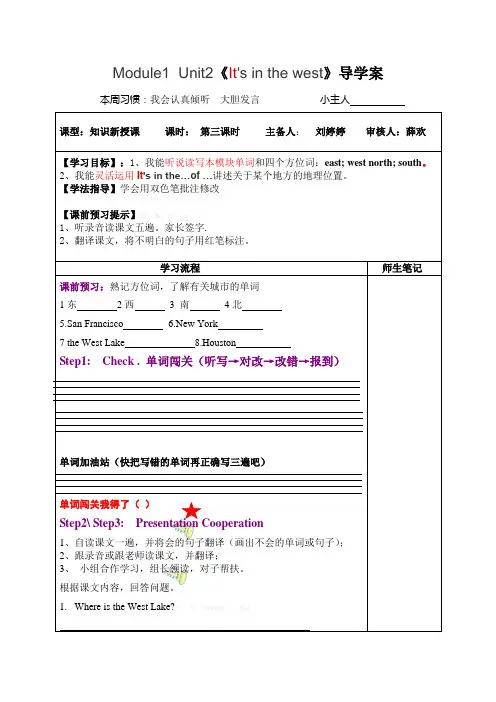
Module1 Unit2《It's in the west》导学案本周习惯:我会认真倾听大胆发言小主人课型:知识新授课课时:第三课时主备人:刘婷婷审核人:薛欢【学习目标】:1、我能听说读写本模块单词和四个方位词:east; west north; south。
2、我能灵活运用It's in the…of …讲述关于某个地方的地理位置。
【学法指导】学会用双色笔批注修改【课前预习提示】X k B 1 . c o m1、听录音读课文五遍。
家长签字.2、翻译课文,将不明白的句子用红笔标注。
学习流程师生笔记课前预习:熟记方位词,了解有关城市的单词1东2西 3 南4北5.San Francisco6.New York7 the West Lake 8.HoustonStep1: Check . 单词闯关(听写→对改→改错→报到)单词加油站(快把写错的单词再正确写三遍吧)单词闯关我得了()Step2\ Step3: Presentation Cooperation1、自读课文一遍,并将会的句子翻译(画出不会的单词或句子);2、跟录音或跟老师读课文,并翻译;3、小组合作学习,组长领读,对子帮扶。
根据课文内容,回答问题。
1.Where is the West Lake? w W w .x K b 1.c o M2.Where is New York?3.Where is San Francisco?4.Where is Houston?Step4: Show孩子们,现在是我们大显身手的时候了!请选择一项任务展示。
组长要合理分配,展示过程中精彩PK,及时补充会额外加分哟!参考任务条:Task1:“课文朗读精英”:展示朗读课文或分角色表演课文;Task2:“句型创编小能手”:根据本课主要句型,创编对话;相信你们还有更多新颖的展示方式,那就PK一下吧!Step5: Consolidation一英汉互译1.a big map of America2. 在中国的东部3.eight million people二根据首字母填空新课标第一网1.W a big map of America!2. Shanghai is in the e of China.达标测评我得了()新课标第一网系列资料。
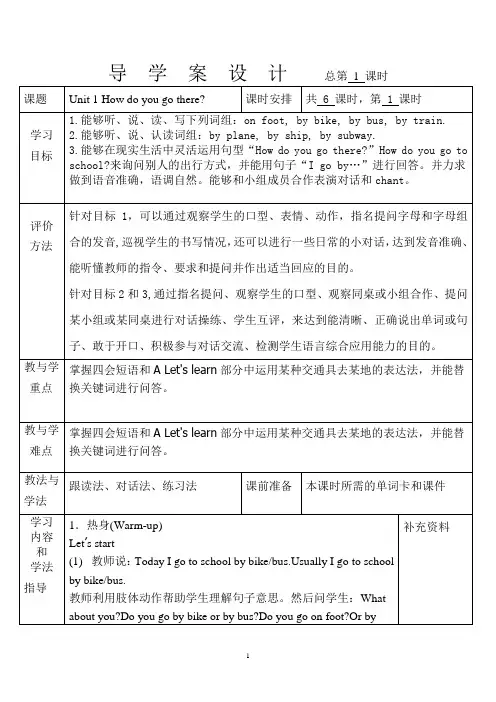
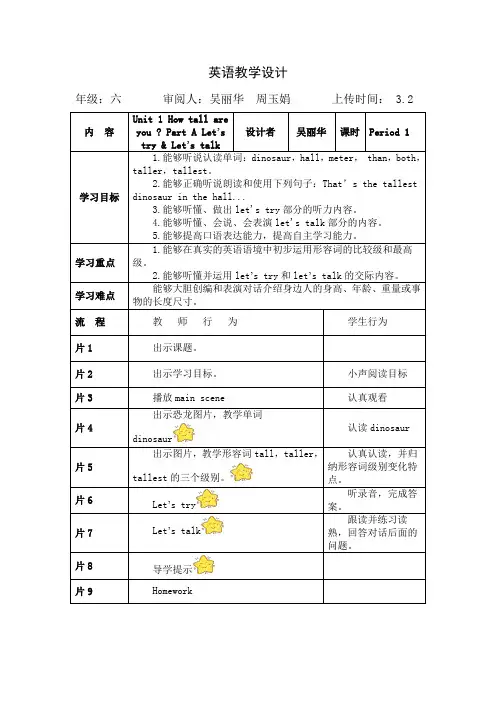
英语教学设计年级:六审阅人:吴丽华周玉娟上传时间: 3.2内容Unit 1 How tall areyou ? Part A Let’stry & Let’s talk设计者吴丽华课时Period 1学习目标1.能够听说认读单词:dinosaur,hall,meter, than,both,taller,tallest。
2.能够正确听说朗读和使用下列句子:That’s the tallest dinosaur in the hall...3.能够听懂、做出let's try部分的听力内容。
4.能够听懂、会说、会表演let's talk部分的内容。
5.能够提高口语表达能力,提高自主学习能力。
学习重点1.能够在真实的英语语境中初步运用形容词的比较级和最高级。
2.能够听懂并运用let’s try和let’s talk的交际内容。
学习难点能够大胆创编和表演对话介绍身边人的身高、年龄、重量或事物的长度尺寸。
流程教师行为学生行为片1 出示课题。
片2 出示学习目标。
小声阅读目标片3 播放main scene 认真观看片4出示恐龙图片,教学单词dinosaur认读dinosaur片5出示图片,教学形容词tall,taller,tallest的三个级别。
认真认读,并归纳形容词级别变化特点。
片6 Let’s try听录音,完成答案。
片7 Let’s talk跟读并练习读熟,回答对话后面的问题。
片8 导学提示片9 Homework板书设计教学反思。
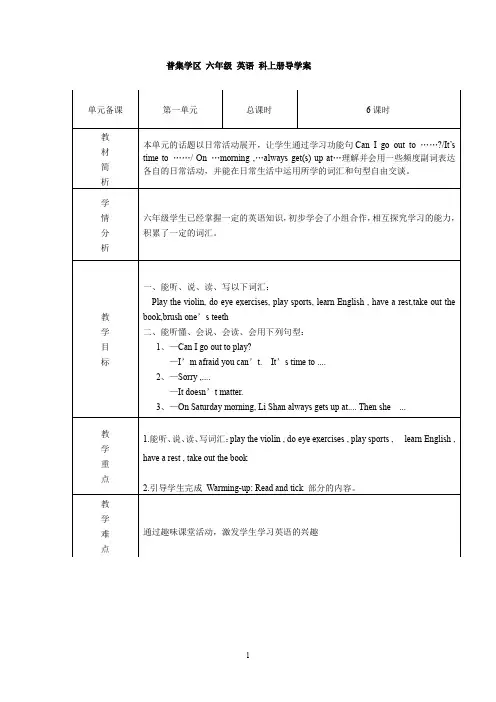
普集学区六年级英语科上册导学案单元备课第一单元总课时6课时教材简析本单元的话题以日常活动展开,让学生通过学习功能句Can I go out to ……?/It’s time to ……/ On …morning ,…always get(s) up at…理解并会用一些频度副词表达各自的日常活动,并能在日常生活中运用所学的词汇和句型自由交谈。
学情分析六年级学生已经掌握一定的英语知识,初步学会了小组合作,相互探究学习的能力,积累了一定的词汇。
教学目标一、能听、说、读、写以下词汇:Play the violin, do eye exercises, play sports, learn English , have a rest,take out the book,brush one’s teeth二、能听懂、会说、会读、会用下列句型:1、—Can I go out to play?—I’m afraid you can’t. It’s time to ....2、—Sorry ,....—It doesn’t matter.3、—On Saturday morning, Li Shan always gets up at.... Then she ...教学重点1.能听、说、读、写词汇:play the violin , do eye exercises , play sports , learn English , have a rest , take out the book2.引导学生完成Warming-up: Read and tick 部分的内容。
教学难点通过趣味课堂活动,激发学生学习英语的兴趣普集学区六年级英语科上册导学案课题Unit 1 It’s time to play the violin 主备人魏喜娟课型新授课时6课时使用人第 1 课时学习目标1.能听、说、读、写词汇:play the violin , do eye exercises , play sports ,learn English , have a rest , take out the book2.引导学生完成Warming-up: Look and circle ; Fill in the form and talk ; Let’s learn 部分的内容。
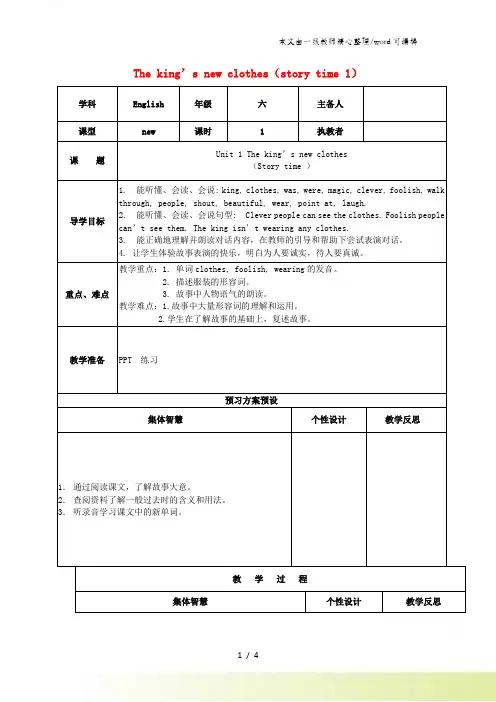
The king’s new clothes(story time 1)学科English 年级六主备人课型new 课时 1 执教者课题Unit 1 The king’s new clothes (Story time )导学目标1. 能听懂、会读、会说: king, clothes, was, were, magic, clever, foolish, walk through, people, shout, beautiful, wear, point at, laugh.2. 能听懂、会读、会说句型: Clever people can see the clothes. Foolish people can’t see them. The king isn’t wearing any clothes.3. 能正确地理解并朗读对话内容,在教师的引导和帮助下尝试表演对话。
4. 让学生体验故事表演的快乐,明白为人要诚实,待人要真诚。
重点、难点教学重点:1. 单词clothes, foolish, wearing的发音。
2. 描述服装的形容词。
3. 故事中人物语气的朗读。
教学难点:1.故事中大量形容词的理解和运用。
2.学生在了解故事的基础上,复述故事。
教学准备PPT 练习预习方案预设集体智慧个性设计教学反思1.通过阅读课文,了解故事大意。
2.查阅资料了解一般过去时的含义和用法。
3.听录音学习课文中的新单词。
教学过程集体智慧个性设计教学反思Step1.1.Greetings2.Free talkWhat day is it today? It’s….T: Welcome to school. Nice to see you again. We have a happy summer holiday.What do you often do on Sundays?What did you do in the summer holiday?S1...S2...S3....Step 2. Pre-reading1.Talk about the writer “安徒生”S1 S2 S3….2.Talk about the works “the king’s new clothes”S1 S2 S3 S43. Talk about the king(learn “king”)Step3.While-reading1. Watch and say1)the time: When did the story happen? (Learn: long long ago, was, were)2)the main characters: Who are in the story?2.Watch the cartoon and choose.1.( ) What did the king like?A. Beautiful clothes.B. New clothes.2. ( )Who visited the king?A.Two men.B. Two women.3. Clever people ( ) see the clothes.Foolish people ( ) see them.A. can’tB. can4.The king walked through the ( ) .A. townB. city5. ( ) pointed at the king and laughed.A. A manB. A little boy3.Fast reading. Read the story individually and try to do T/F1. The king liked new clothes. ______2.Two men showed the king some magic clothes.3.The king was foolish. ______4.People could see the king’s new clothes. _____5.The boy was foolish because he could not seethe king’s new clothes. ______3. learn Paragraph 1.1)Read and answer:2)Read it together.4. learn Paragraph 2.1)read and complete the following sentence: 让学生提前预习了解安徒生通过提问让学生了解课文大意反复阅读,培养学生的阅读能力分段讲解可以让学生把不理解的地方提问出来According to the two men, the king’s new clothes are .Because .(learn: magic, clever, foolish)2)Listen and repeat.5.Paragraph 3 and 4: read in pairs/groups and act. 1)The king walked through the city in his new clothes.Learn: walk through.2)What did the people say? Try to act and say. 3)What did the boy say? Try to act and say4)Learn the new words: shout, point at, laugh.And pay attention to the pronunciation of the words: looked, shouted, pointed, laughing5)What do you think of the boy and the people in the street? Why?6.Read and finish the exercise.1)Read and do the exercise.2)Check.3)Read the whole story together.Step4.Post-reading1.Act the story in groups.2.Try to retell.作业布置1.Read the story.2.Read more English stories from the Internet or bookshops.板书设计Unit 1 The king’s new clothesThe king ….. clever Two men ….. foolish A little boy …… peoplePoint at …..laugh。
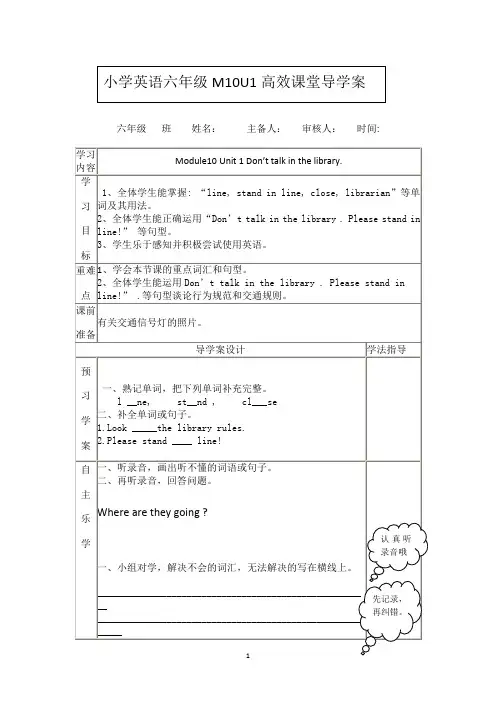
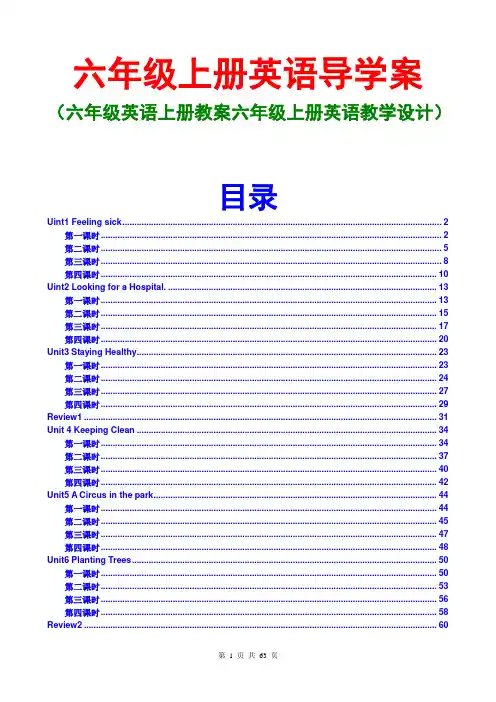
六年级上册英语导学案(六年级英语上册教案六年级上册英语教学设计)目录Uint1 Feeling sick (2)第一课时 (2)第二课时 (5)第三课时 (8)第四课时 (10)Uint2 Looking for a Hospital. (13)第一课时 (13)第二课时 (15)第三课时 (18)第四课时 (20)Unit3 Staying Healthy (23)第一课时 (23)第二课时 (25)第三课时 (27)第四课时 (30)Review1 (31)Unit 4 Keeping Clean (34)第一课时 (34)第二课时 (37)第三课时 (40)第四课时 (42)Unit5 A Circus in the park (44)第一课时 (44)第二课时 (45)第三课时 (47)第四课时 (48)Unit6 Planting Trees (50)第一课时 (50)第二课时 (53)第三课时 (56)第四课时 (58)Review2 (61)Uint1 Feeling sick第一课时一、课题:Feeling sick二、课型:Words 、Target三、教学目标:1、能正确拼读单词。
2、能正确朗读本单元重点句型。
3、能综合运用本单元的单词和句型谈论有关病情4、教育学生要锻炼身体保持身心健康四、教学重难点: 认记单词,并运用所学句型进行扩展性会话。
五、学与教的方式:学生自主学习,小组合作学习和教师讲解相结合。
六、教学过程1、知识回顾:1)语音练习 2)复习学过的人体单词。
2、学习Vocabulary和Target(学法指导:认真听录音后教师点拨语音难点(有必要时要带读)——小组自主学习:过程:组长带读——组员一起拼读——自由朗读——背诵。
(教学说明:学生根据已有的语音基础拼读单词、这是学生自学英语的基本能力。
)3、展示环节:(教师了解各组学习情况)全班齐读——教师抽查——个人发挥4、反馈:我在小组自主学习时,觉得容易读错的单词有,我会默写的单词有5、学习以下知识点:(1)should 是“应该”的意思,后面加动词原形,。
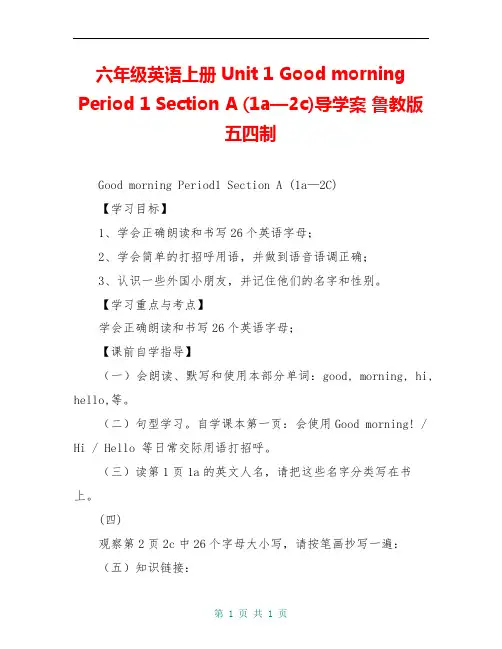
六年级英语上册 Unit 1 Good morning Period 1 Section A (1a—2c)导学案鲁教版五四制Good morning Period1 Section A (1a—2C)【学习目标】1、学会正确朗读和书写26个英语字母;2、学会简单的打招呼用语,并做到语音语调正确;3、认识一些外国小朋友,并记住他们的名字和性别。
【学习重点与考点】学会正确朗读和书写26个英语字母;【课前自学指导】(一)会朗读、默写和使用本部分单词:good, morning, hi, hello,等。
(二)句型学习。
自学课本第一页:会使用Good morning! / Hi / Hello 等日常交际用语打招呼。
(三)读第1页1a的英文人名,请把这些名字分类写在书上。
(四)观察第2页2c中26个字母大小写,请按笔画抄写一遍:(五)知识链接:2、英语字母书写的规格1)每个字母都应稍向右倾斜,约为5,斜度要一致。
如图:(2)大写字母都应一样高,占上面两格。
(3)书写单词时,字母与字母之间的间隔要均匀、适当,不要凑得过紧,也不要离得太远。
(4)应按照字母的笔顺和字母在三格中应占的位置书写。
3、怎样用英语打招呼?Good morning!是早上或上午的见面问候语,它的回答仍用Good morning!打招呼还可用Hello!或Hi! Hello!“你好”,是比较随便,不分时间的一种问候语,对方回答用Hello!或Hi!。
Hi比Hello使用时更随便,在年轻人中使用更为普遍小试牛刀1、按字母表顺序重排下列字母。
1)epaqbgc_________________2)dchbey____________________3)XCFDEL_________________4)OCSBMDA________________5)yhfgep____________________6)NGFBDR__________________7)ngya_______________________8)QBXTG___________________2、早晨,熟人见面可以说_____________________________________、老师说“Good morning!”,学生们应说____________________________通过自主学习,你有哪些疑问:【学习过程】(一)导入并出示学习目标;(二)自主学习情况交流:1、你们组同学的“自主学习”完成的怎么样?看谁完成的最好?2、讨论、对比并解决“小试牛刀”部分。
人教版小学六年级英语上册导学案Unit 1How can I get there?第一课时Main scene & Part A Let's learn,Make a map and talk1.Words(单词):science museum,post office,bookstore,cinema,hospital 2.Sentences(句子):—Where is the science museum?—It's near the library.1.掌握本节课重点单词。
2.掌握句型:Excuse me.Where is the science museum? It's near the library.Step 1温故习新(5 minutes)1.Greetings.(T—teacher,S—student)2.T:Can you sing English songs?S:Yes,I can.T:What are you doing?S:I'm reading a book/writing a letter.Step 2新课展示(15 minutes)1.T:Show word cards to teach the new words:science,museum,post office,bookstore,cinema,hospital2.T:Where is our school?(引导学生回答)S:It's near/behind Xinhua Bookstore.T:Where is the bookstore?S:It's near the post office.3.运用所学句型操练Let's learn。
Step 3合作交流(10 minutes)1.运用图片操练重要单词和词组。
2.T:There is a bookstore in our city.Where is it?S:It's next to the post office.(可小组操练)3.Make a map and talk.Step 4名师自测(5 minutes)一、读单词,选汉意。
六年级英语(上)课堂导学案
六年级英语(上)课堂导学案
六年级英语(上)课堂导学案
六年级英语(上)课堂导学案
六年级英语(上)课堂导学案
六年级英语(上)课堂导学案
六年级英语(上)课堂导学案
六年级英语(上)课堂导学案
六年级英语(上)课堂导学案
六年级英语(上)课堂导学案
六年级英语(上)课堂导学案
六年级英语(上)课堂导学案
六年级英语(上)课堂导学案
六年级英语(上)课堂导学案
六年级英语(上)课堂导学案
六年级英语(上)课堂导学案
六年级英语(上)课堂导学案
六年级英语(上)课堂导学案
六年级英语(上)课堂导学案
六年级英语(上)课堂导学案
六年级英语(上)课堂导学案
六年级英语(上)课堂导学案
六年级英语(上)课堂导学案
六年级英语(上)课堂导学案
六年级英语(上)课堂导学案。
六年级上册英语学科导学案
六年级上册英语学科导学案
六年级上册英语学科导学案
六年级上册英语学科导学案
六年级上册英语学科导学案
六年级上册英语学科导学案
六年级上册英语学科导学案
六年级上册英语学科导学案
六年级上册英语学科导学案
六年级上册英语学科导学案
六年级上册英语学科导学案
六年级上册英语学科导学案
六年级上册英语学科导学案
六年级上册英语学科导学案
六年级上册英语学科导学案
标准
文案。
Unit 1 What did you do during the holidays?【学习目标】一、词汇:during在……期间, holiday假日, learn学习, practise 练习, speak说, learn words and sentences学习单词和句子, play games 玩游戏,learn writing, practise listening二、句型:—What did you do during the holidays?假期里你做了什么?—I read many books.我看了许多书。
三、语法:一般过去时导学:试读试写试说试练【试读试写】一、根据汉语意思写单词。
1、学习________________ 2.练习________________3、假日________________ 4.在......期间__________________二、选择画线部分正确的汉语意思。
()1.Take out your book.A.放下B.拿出C.打开()2.The bell rang.A.铃B.电话C.电视机()3.Why didn’t you run around the tree?A.如何B.什么C.为什么()4.I became a good swimmer.A.游泳B.游泳者C.去游泳【试说试练】模仿,会说并能用下列句子进行会话练习:What did you do during the holidays?I read many books.议学:试悟试练【试悟试练】一般过去时:表示过去做的事情。
句子中动词要变成过去式。
动词过去式的变化规则:1.一般情况直接在词尾加ed,如work—worked 工作2.以字母e结尾的动词只加d,如practise—practised 练习3.以辅音字母加y结尾的,先变y为i再加ed,如worry—worried 担心4.以重读闭音节结尾的,先双写最后一个字母,再加ed,如stop—stopped 停止特殊变化的动词过去式如下表:练习:写出下列过去式的原形形式。
学习目标:1. 能够听懂并朗读本单元中的单词,短语和对话;2. 能运用句型What did you do during the holidays? I…来谈论自己假期中所做的事情。
重点:能够熟练运用本单元中句型来谈论自己或他人假期中所做的事情。
难点:能听懂,认读和运用during, holiday, learn, practise, speak等词,来谈论假期中所做的事情。
Last week, Tim and Dino played an interesting game in class. Tim said, “Simon says, ‘Stand up!’” Dino stood up. Tim said, “Simon says, ‘Sit down!’” Dino sat down. Tim said, “Take out your book.” Dino did not take it out.The bell rang. Tim and Dino went out of the classroom. Dino said to Tim, “Simon says, ‘Run to the tree and climb it.’” Tim ran to the tree and climbed it. And then Tim said to Dino, “Simon says, ‘Run around the tree!’” But Dino didn’t. “Why didn’t you run around the tree?” asked Tim. Dino said, “Class is over!”【知识精讲】1. learn v. 学习作为动词,用法如下:(1) learn sth. 学习某事(2) learn to do sth. 学习做某事(3) learn… from sb. 向某人/某物学习……His brother is learning English now. 他的弟弟现在正在学习英语。
1 Unit 1 How can I get there? 第一课时导学案 学习内容(Learning contents):Unit 1 Let’s try Let’s talk Let’s learn
学习目标(Learning aims) (1)听懂、会说、正确读写短语:in the museum in the bookstore in hospital at the cinema near the door next to the museum want to buy a postcard(本节学习重难点) (2)能正确询问并回答某地在哪Where is/are„? It/They is/are„. (本节学习重难点)
知识链接:(Knowledge links) 1. 单词where 的简介:where 是一个特殊疑问词,常用来对地点询问,例如:Where is the museum shop? It’s near the door! 2. 介词in和at的用法:大家一定要记牢:在地点名词前,既可以in,也可以用at。大地方一般用in,小地方用in at都可以
学习指导(Learning guide) 1.自主学习短语in the museum in the bookstore near the door next to the museum want to buy a postcard in the bookstore in hospital at the cinema(试读,试翻译,可以借助单词表) 2. 听懂、会说、正确读写上面的短语(自己能独立背会并默写) 3. 根据本节学习到的知识,独立完成导学案。(在自学过程中注意记录自己解决不了的问题,以便和他人合作交流)
自主学习(Self-learning) 1. 你能正确读出下面的词组吗?你能正确翻译它们的汉语意思吗?来试试吧!(自学,可借助单词表) in the museum( ) in the bookstore ( ) near the door ( ) next to the museum( ) want to buy a postcard( ) in the bookstore ( ) in hospital ( ) at the cinema ( ) 2. 你能流利读出下面的句子吗?你知道它们的汉语意思吗? Where is the museum shop? It’s near the door!
Where is the post office? It’s next to museum. 2
合作探究(Group work) (小组内讨论交流展示,组员推荐一人在全班展示。) 1.你能正确读出上面的词组吗?大声读给你的组员听吧!听谁的发音最正确。 (1) 小组内自由读。 (2) 小组推荐优秀组员展示读,并领读,全班同学跟读。
2.你能用英语写出下面的句子吗? (1)博物馆商店在哪里?他在门附近。
_____________________________________________________ (2)邮局在哪里?他挨着博物馆。
____________________________________________________ 小组展示(Group show) 对合作探究中的两个问题进行展示。
课堂小结(Summary) 这节课我学会了
___________________________________________ _________________________________________________________。 巩固延伸(Consolidation and extension) Talk about the museum shop/post office? Talk about the places in your city/town/village?
Is there a„? Where is it?
It’s near/next to/behind„ park library zoo
post office school museum hospital cinema 3
课堂检测(Test) 1.你能写出正确的短语吗? 在邮局_______________ 想买一张贺卡______________ 打扰了 _______________ 挨着博物馆______________ 我不知道_____________ 一个说话的机器人______________
2.连词成句: (1) post where office the is ________________________________________ (2)bookstore it’s next the to. _________________________________________ 3.你能用英语写出下面的句子吗? (1)博物馆商店在哪里?他在门附近。
_____________________________________________________ (2)邮局在哪里?他挨着博物馆。
____________________________________________________ 4
Unit 1 How can I get there? 第二课时导学案 学习内容(Learning contents):Unit 1 Make a map and talk Let’s try Let’s talk
学习目标(Learning aims) 1.能听懂、会说、流利读、正确书写四会句子:“How can we get there? Turn left at the bookstore. Then turn right at the hospital.”(本节课学习重点) 2.能够听懂Let's try的录音内容并选出正确选项 3.能够表述问路及指点路,如:How can we get there? Turn left at the bookstore. Then turn right at the hospital. (本节课学习难点)
知识链接:(Knowledge links) 1. There be句型:表示某地有某物。 2. 单词how 的简介:how 是一个特殊疑问词,常用来对身体状况进行询问,例如:How are you? I’m fine.Thank you!在本节的学习中,how 还有另外一种用法,主要对方式提问
学习指导(Learning guide) 1.自主学习对话(试读试翻译,可以借助单词表,不会的注意作标记) 2.流利背诵对话。(自己能独立背并默写重点句型) 3.根据本节学习到的知识,独立完成导学案。
旧知复习(Revision) 科学博物馆________________ 邮局 __________________ 书店_________________ 电影院____________ 医院__________ 图书馆_____________
自主学习(Self-learning) 1. 你能完成听音练习吗? Listen and tick or cross. ( ) They want to go to the bookstore. ( ) The cinema is next to the bookstore. 5
2. 你能正确读出下面的句子吗?你能正确翻译它们的汉语意思吗?来试试吧!(自学,可同桌交流) How can we get therel?
Turn left at the bookstore. Then turn right at the hosipal. 合作探究(Group work) (小组内讨论交流展示,组员推荐一人在全班展示。) 1.你能流利朗读对话吗?大声读给你的组员听吧!听谁的发音最正确。 ( 1 )小组内自由读。 (2)各小组长领读,全班跟读。 (3)小组推荐优秀组员分角色表演。 2.你能用英语写出下面的句子吗? (1)我们怎么能到那?在书店向左转,然后在医院向右转。
_____________________________________________________ (2)它在东方大街,挨着公园。
____________________________________________________ 小组展示(Group show) 对合作探究中的两个问题进行展示。 课堂小结(Summary)
这节课我学会___________________________________________ 巩固延伸(Consolidation and extension) 1. 看图仿写对话(课本第六页)。 2. 组内展示所写对话。 6
3. 小组交流,完成Group work. I like „ How can I get to the„ Turn left/right at„
课堂检测(Test) 一.连词成句。 1.I how get can to Zhongshan Park(?)
________________________________________ 2.left turn the at bookstore(?)_______________________ 二.改错,并纠正。 1.How can you go school? _______→_______ 2.Turn the left at the bookstore. _______→_______ 3. What a interesting film. _______→_______ 4.Turn right on the hospital _______→_______ 5.What can I go there? _______→_______